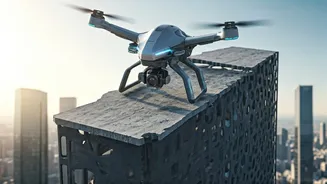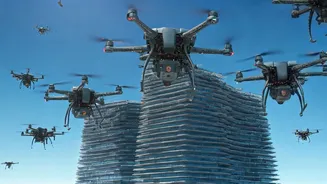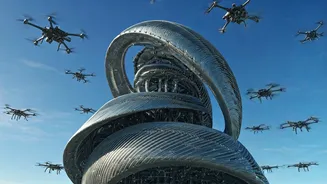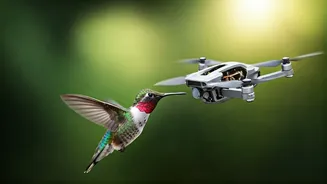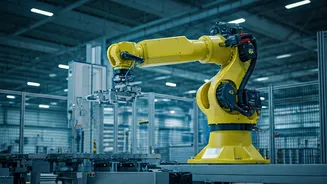Drones Take Flight
The field of construction is undergoing a dramatic transformation, and at the forefront of this change are AI-powered drones. These sophisticated machines
are no longer just tools for inspection; they are now actively participating in the building process. Carnegie Mellon University has been making strides in this area, demonstrating a system that uses drones to 3D-print structures mid-air, with an astonishing success rate of 90%. This achievement is a testament to the advancements in artificial intelligence, robotics, and material science. These drones are programmed with the ability to analyze their environment, adjust their movements, and precisely deposit construction materials, all while suspended in the air. This novel approach opens up exciting possibilities for construction projects in challenging environments and previously inaccessible locations.
Mid-Air 3D Printing
The core of this innovation lies in the drones' capacity for mid-air 3D printing. This method employs a layer-by-layer material deposition technique, where the drones meticulously deposit construction materials to create the intended structure. The drones' AI algorithms and sensors enable them to maintain precise control over their movements, ensuring the construction material is placed exactly as planned. This technology has the potential to produce complex geometries and customized structures, going beyond the limitations of traditional construction methods. The 90% success rate indicates a high degree of reliability and precision in this process, highlighting the advanced capabilities of the AI and robotics involved. This also means fewer material waste and faster project completion times, paving the way for a more sustainable and efficient construction industry.
Success Rate & Details
The remarkable success rate of 90% achieved by Carnegie Mellon's AI-powered drones is an impressive figure, indicating the reliability and sophistication of the technology. This high success rate is a result of the careful coordination between AI algorithms, sensor systems, and the drones' mechanical capabilities. The drones are equipped with advanced sensors that allow them to accurately assess their position, the surrounding environment, and the materials being used. The AI algorithms process this data in real-time, making adjustments to the drones' movements and material deposition patterns to ensure precision. Although specific details regarding the materials are not given, this technology could use a range of materials, including concrete, polymers, and even specialized materials. It also enables architects and engineers to design structures with unprecedented freedom and complexity, making innovative and efficient designs a reality.
Future Construction?
The implications of this technology extend far beyond the construction industry. These AI-powered drones could be deployed in various challenging environments where traditional construction methods are impractical or dangerous. They can be used to build in disaster zones, remote locations, and even in space. Furthermore, the use of mid-air 3D printing could significantly reduce construction waste and improve resource efficiency, making the industry more sustainable. The ability to customize structures allows for bespoke designs tailored to unique requirements. As the technology continues to develop, expect further refinements in material science, AI algorithms, and drone design, which could revolutionize how we build our world. This technology holds great promise in areas like infrastructure development, disaster relief, and even creating structures in locations that were previously thought impossible.
